
I thought this video clip was entertaining as well as pretty interesting… enjoy! Here is part 1:
… and part 2 (tells you how to adjust and use your J-38 key):
Amateur Radio – a hobby where people talk about their hobby using their hobby.

I thought this video clip was entertaining as well as pretty interesting… enjoy! Here is part 1:
… and part 2 (tells you how to adjust and use your J-38 key):
 I stopped by McDonald’s this morning to grab some breakfast and the gentleman behind the counter taking the ordered ended up being a former Iraqi interpreter for US forces. He was able to wade through the visa program and had recently arrived here to the US. Most Americans have no idea the critical value that Iraqi interpreters provide – it goes well beyond simple translation. These young men (and few women) are paid very little, are often not allowed to carry weapons, and go into some of the most dangerous places side by side with their American units. Beyond the ability to translate, the interpreter serves as a cultural guide and sometimes diplomat… gently coaching American officers through the nuances of Iraqi culture that are so critical when dealing the local population. Beyond the personal danger the interpreters undergo, there is the very real threat to their family should it be found out that they are supporting coalition forces. In 2007, President Bush expanded the visa program to help bring over interpreters from Iraq to the US in recognition of their service. Navigating the unnecessarily complex visa process is just one of the first hurdles these future US citizens face. If you encounter a former Iraqi interpreter, please keep in mind the great debt our government owes him.
I stopped by McDonald’s this morning to grab some breakfast and the gentleman behind the counter taking the ordered ended up being a former Iraqi interpreter for US forces. He was able to wade through the visa program and had recently arrived here to the US. Most Americans have no idea the critical value that Iraqi interpreters provide – it goes well beyond simple translation. These young men (and few women) are paid very little, are often not allowed to carry weapons, and go into some of the most dangerous places side by side with their American units. Beyond the ability to translate, the interpreter serves as a cultural guide and sometimes diplomat… gently coaching American officers through the nuances of Iraqi culture that are so critical when dealing the local population. Beyond the personal danger the interpreters undergo, there is the very real threat to their family should it be found out that they are supporting coalition forces. In 2007, President Bush expanded the visa program to help bring over interpreters from Iraq to the US in recognition of their service. Navigating the unnecessarily complex visa process is just one of the first hurdles these future US citizens face. If you encounter a former Iraqi interpreter, please keep in mind the great debt our government owes him.
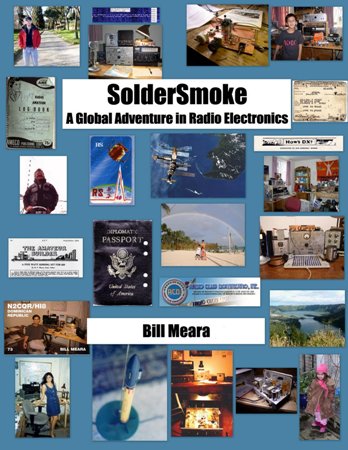 SolderSmoke: A Global Adventure in Radio Electronics, by Bill Meara, N2CQR, takes the reader on a journey into the magic of radio and the essence of the amateur radio hobby. The book is both a personal journal and a workbench notebook. Bill weaves together his exploration of radio through both his experiences since joining the hobby as a boy and the continual development of his conceptualization and resulting understanding of the basics of electronics. With a liberal arts education, Bill’s exploration of electronics becomes a passionate pursuit driven by questions not easily explained by standard text book answers. Anyone who has enjoyed listening to a SolderSmoke podcast knows that Bill is a wonderful storyteller. His narrative traces his development in the hobby: early years as a boy, an Army private at Fort Gordon, GA experiencing the Signal Corps school, his reemergence in the hobby upon the start of a State Department posting in the Dominican Republic, followed by tours in the Azores, London, and Rome. Bill’s interests in amateur radio covers many of its facets. He makes contact with a Russian OSCAR satellite, talks to an astronaut aboard MIR, and catches the homebrewing bug – building an AM rig, a dual side-band rig that he uses on 17M and other completely homebrewed projects. His job with the State Department allows him to enjoy the hobby from exotic locations around the globe. The fellow hams he meets (both on air and locals) adds to his adventures. Whether a fellow homebrewer is sending him a hard to get part or he works a local ham in the Dominican Republic via a satellite-based VHF repeater, Bill brings to life the camaraderie of the amateur radio fellowship. His journey takes him beyond the basic equations of electronic theory and explores some of the fundamental questions behind the formulas. I would recommend this book for anyone who views amateur radio gear as more than just a collection of transistors, capacitors, diodes, and solder. SolderSmoke (the book) is one man’s journey into the soul of ham radio. It is a wonderful, amazing quest to unlock the magic of the electron.
SolderSmoke: A Global Adventure in Radio Electronics, by Bill Meara, N2CQR, takes the reader on a journey into the magic of radio and the essence of the amateur radio hobby. The book is both a personal journal and a workbench notebook. Bill weaves together his exploration of radio through both his experiences since joining the hobby as a boy and the continual development of his conceptualization and resulting understanding of the basics of electronics. With a liberal arts education, Bill’s exploration of electronics becomes a passionate pursuit driven by questions not easily explained by standard text book answers. Anyone who has enjoyed listening to a SolderSmoke podcast knows that Bill is a wonderful storyteller. His narrative traces his development in the hobby: early years as a boy, an Army private at Fort Gordon, GA experiencing the Signal Corps school, his reemergence in the hobby upon the start of a State Department posting in the Dominican Republic, followed by tours in the Azores, London, and Rome. Bill’s interests in amateur radio covers many of its facets. He makes contact with a Russian OSCAR satellite, talks to an astronaut aboard MIR, and catches the homebrewing bug – building an AM rig, a dual side-band rig that he uses on 17M and other completely homebrewed projects. His job with the State Department allows him to enjoy the hobby from exotic locations around the globe. The fellow hams he meets (both on air and locals) adds to his adventures. Whether a fellow homebrewer is sending him a hard to get part or he works a local ham in the Dominican Republic via a satellite-based VHF repeater, Bill brings to life the camaraderie of the amateur radio fellowship. His journey takes him beyond the basic equations of electronic theory and explores some of the fundamental questions behind the formulas. I would recommend this book for anyone who views amateur radio gear as more than just a collection of transistors, capacitors, diodes, and solder. SolderSmoke (the book) is one man’s journey into the soul of ham radio. It is a wonderful, amazing quest to unlock the magic of the electron.
The book [softbound, 195 pages] is self-published and available from Lulu or Amazon.com for $22.99.
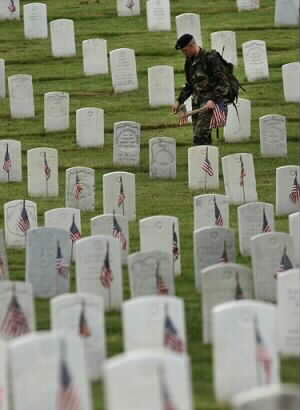 Memorial Day was originally known as Decoration Day because it was a time set aside to honor the nation’s Civil War dead by decorating their graves. It was first widely observed on May 30, 1868, to commemorate the sacrifices of Civil War soldiers, by proclamation of General John A. Logan of the Grand Army of the Republic, an organization of former sailors and soldiers. On May 5, 1868, Logan declared in General Order No. 11 that:
Memorial Day was originally known as Decoration Day because it was a time set aside to honor the nation’s Civil War dead by decorating their graves. It was first widely observed on May 30, 1868, to commemorate the sacrifices of Civil War soldiers, by proclamation of General John A. Logan of the Grand Army of the Republic, an organization of former sailors and soldiers. On May 5, 1868, Logan declared in General Order No. 11 that:
The 30th of May, 1868, is designated for the purpose of strewing with flowers, or otherwise decorating the graves of comrades who died in defense of their country during the late rebellion, and whose bodies now lie in almost every city, village, and hamlet churchyard in the land. In this observance no form of ceremony is prescribed, but posts and comrades will in their own way arrange such fitting services and testimonials of respect as circumstances may permit.
During the first celebration of Decoration Day, General James Garfield made a speech at Arlington National Cemetery, after which 5,000 participants helped to decorate the graves of the more than 20,000 Union and Confederate soldiers buried in the cemetery.
This 1868 celebration was inspired by local observances of the day in several towns throughout America that had taken place in the three years since the Civil War. In fact, several Northern and Southern cities claim to be the birthplace of Memorial Day, including Columbus, Miss.; Macon, Ga.; Richmond, Va.; Boalsburg, Pa.; and Carbondale, Ill.
In 1966, the federal government, under the direction of President Lyndon Johnson, declared Waterloo, N.Y., the official birthplace of Memorial Day. They chose Waterloo—which had first celebrated the day on May 5, 1866—because the town had made Memorial Day an annual, community-wide event during which businesses closed and residents decorated the graves of soldiers with flowers and flags.
By the late 1800s, many communities across the country had begun to celebrate Memorial Day and, after World War I, observances also began to honor those who had died in all of America’s wars. In 1971, Congress declared Memorial Day a national holiday to be celebrated the last Monday in May. (Veterans Day, a day set aside to honor all veterans, living and dead, is celebrated each year on November 11.)
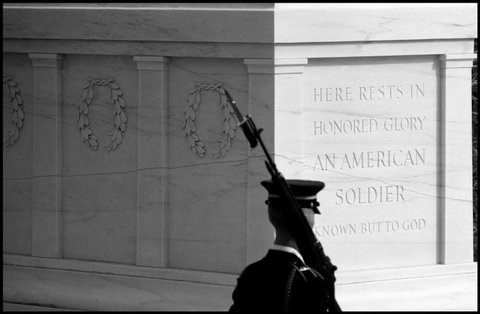
Today, Memorial Day is celebrated at Arlington National Cemetery with a ceremony in which a small American flag is placed on each grave. Also, it is customary for the president or vice-president to give a speech honoring the contributions of the dead and lay a wreath at the Tomb of the Unknown Soldier. About 5,000 people attend the ceremony annually.
For me the past few days have been busy with amateur radio activity of one kind or another. I spent some time last weekend fine tuning my horizontal loop antenna; spreading it out the loop a bit and raising it higher. I am still impressed by the antenna’s performance and look forward to using it for the remaining year I am here in Kansas.
I delivered my presentation on the history of Army hams operating abroad (WWII to OIF) and my own experiences operating amateur radio and MARS while recently serving over in Iraq to three different Kansas City area clubs this week (Tuesday, Thursday, Friday). In April, I gave the presentation to three other clubs – two in Missouri and one in Kansas. Overall, what impressed me the most concerning the club meetings I visited was the diversity and vibrancy of amateur radio in the Kansas City area. It is not just a bunch of OMs or converted CBers or EMCOMM devotees.
 Last night I attended a meeting at the Johnson County Amateur Radio Club in Overland Park, KS. Not only was the meeting well attended (and we are talking about a Friday night before a major holiday weekend) but their were not only a number of YLs but also four teen-aged hams… one of which was Duncan MacLachlan, KU0DM, who is the ARRL’s Youth Editor and was featured prominently at last weeks Hamvention in Dayton on the ARRL weblog. Duncan had just concluded a years service to the club as its vice-president. This club also meets twice a month and has a 10M weekly net in addition to its 2M net.
Last night I attended a meeting at the Johnson County Amateur Radio Club in Overland Park, KS. Not only was the meeting well attended (and we are talking about a Friday night before a major holiday weekend) but their were not only a number of YLs but also four teen-aged hams… one of which was Duncan MacLachlan, KU0DM, who is the ARRL’s Youth Editor and was featured prominently at last weeks Hamvention in Dayton on the ARRL weblog. Duncan had just concluded a years service to the club as its vice-president. This club also meets twice a month and has a 10M weekly net in addition to its 2M net.
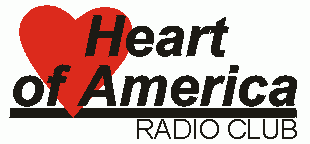 On Tuesday I attended the meeting of the Heart of America Radio Club. The club conducts its operations out of the Red Cross headquarters in Kansas City. They had not only a wonderful club station on the top floor of the building with a impressive antenna farm on the roof but also operated 1 of the 12 Red Cross national communications support vehicles. The vehicle is a modified Ford Excursion with so many antennas on it I couldn’t count. It provides one stop shopping for any communication requirement from providing internet, VOIP phone, long-haul HF comms, phone patching, video, and an on-board cross-band repeater, as well as a generator that can power a medium-sized command post.
On Tuesday I attended the meeting of the Heart of America Radio Club. The club conducts its operations out of the Red Cross headquarters in Kansas City. They had not only a wonderful club station on the top floor of the building with a impressive antenna farm on the roof but also operated 1 of the 12 Red Cross national communications support vehicles. The vehicle is a modified Ford Excursion with so many antennas on it I couldn’t count. It provides one stop shopping for any communication requirement from providing internet, VOIP phone, long-haul HF comms, phone patching, video, and an on-board cross-band repeater, as well as a generator that can power a medium-sized command post.
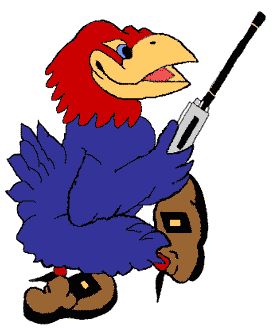 Thursday night I was out at the Jayhawk Amateur Radio Society meeting. Another vibrant club with a large turnout… in part due to the coffee and delicious cake offered up during the meeting’s intermission but also the true shared interest in amateur radio. The Jayhawkers gave me a super cool coffee mug with their logo on it at the conclusion of the meeting which will now become the official mug of my ham shack.
Thursday night I was out at the Jayhawk Amateur Radio Society meeting. Another vibrant club with a large turnout… in part due to the coffee and delicious cake offered up during the meeting’s intermission but also the true shared interest in amateur radio. The Jayhawkers gave me a super cool coffee mug with their logo on it at the conclusion of the meeting which will now become the official mug of my ham shack.
Bottom line (… and quickly becoming an often heard refrain), ham radio is alive and well.
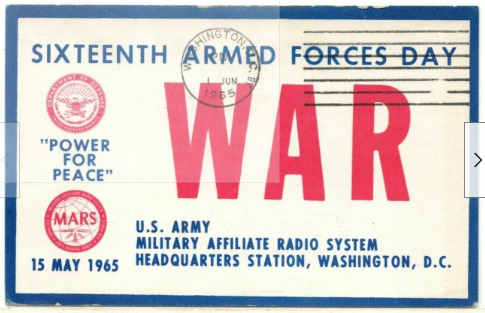 The Army, Air Force, Navy, Marine Corps, and Coast Guard are co-sponsoring the annual military/amateur radio communications tests in celebration of the 59th Anniversary of Armed Forces Day (AFD). Although the actual Armed Forces Day is celebrated on Saturday, May 16, 2009, the AFD Military/Amateur Crossband Communications Test will be conducted 09 May 2009 to prevent conflict with the Dayton Hamvention (15-17 May 2009), which is the same weekend as the actual Armed Forces Day.
The Army, Air Force, Navy, Marine Corps, and Coast Guard are co-sponsoring the annual military/amateur radio communications tests in celebration of the 59th Anniversary of Armed Forces Day (AFD). Although the actual Armed Forces Day is celebrated on Saturday, May 16, 2009, the AFD Military/Amateur Crossband Communications Test will be conducted 09 May 2009 to prevent conflict with the Dayton Hamvention (15-17 May 2009), which is the same weekend as the actual Armed Forces Day.
The annual celebration features traditional military to amateur cross band communications SSB voice tests and copying the Secretary of Defense message via digital modes. These tests give Amateur Radio operators and Short Wave Listeners (SWL) an opportunity to demonstrate their individual technical skills, and to receive recognition from the Secretary of Defense and/or the appropriate military radio station for their proven expertise. QSL cards will be provided to those stations making contact with the military stations. Special commemorative certificates will be awarded to anyone who receives and copies the digital Armed Forces Day message from the Secretary of Defense.
MILITARY-TO-AMATEUR CROSS BAND SSB & CW TEST CONTACTS.
Military-to-Amateur cross band operations will take place on the dates/times in ZULU (UTC), and frequencies listed below for each station. Voice contacts will include operations in single sideband voice (SSB). Some stations may not operate the entire period, depending on propagation and manning. Participating military stations will transmit on selected Military MARS frequencies and listen for amateur radio stations in the Amateur bands indicated below. The military station operator will announce the specific amateur band frequency being monitored. Duration of each voice contact should be limited to 1-2 minutes. The following stations will be transmitting on MARS frequencies listed below which are provided as “Window/Dial Frequency” in kHz.
Some stations will use CW to provide the opportunity to check in by Morse Code
Army Stations
STATION: AAZ (09 May 1400Z – 10 May 0300Z)
Frequency Emission Amateur Band
4038.9 kHz LSB 80M
6913.0 kHz LSB 40M
14.402.0 kHz USB 20M
13996.0 kHz USB 20M
18211.0 kHz USB 17M
7577.0 kHz CW 40M
13507.0kHz CW 20M
7639.5 kHz RTTY 40M
13512.5 kHz MT-63 20M
Location: Fort Huachuca, AZ
Address:
Commander NETCOM/9th ASC
ATTN: NETCOM-OPE-M (MARS) (31)
2133 Cushing Street
Ft. Huachuca, AZ 85616-7070
POC: Mr. Dewayne Smith
DSN: 821-7324
Commercial: (520) 533-7324
STATION: AAC (09 May 1300Z – 10 May 0100Z)
Frequency Emission Amateur Band
3348.5 kHz LSB 80M
7363.0 LSB 40M
9180.5 MT63 USB 30M
13910.5 kHz USB 20M
Location: Lexington, KY
Address:
HQ 1st BDE, 100th DIV (IT) MARS Station
Barrow Army Reserve Training Center
1051 Russell Cave Pike
Lexington, KY 40505
POC: Barry Jackson
Commercial: (859) 227-0137
STATION: ABH (09 May 1600Z – 10 May 2300Z)
Frequency Emission Amateur Band
3195 kHz LSB 80M
3360 kHz LSB 80M
4440 kHz LSB 80M
4466 kHz LSB 80M
7360 kHz LSB 40M
7720 kHz LSB 40M
8040 kHz LSB 40M
8094.5 kHz LSB 40M
14483.5 kHz USB 20M
14489.5 kHz USB 20M
17443.0 kHz USB 17M
17592.5 kHz USB 17M
20978.0 kHz USB 15M
20559.0 kHz USB 15M
Location: Schofield Barracks, HI
Commander, 396th Signal Company
30th Signal Battalion, 96857
POC: WO1 William Pemberton
Commercial: (808) 655-3387
STATION: ALM (09 May 1600Z – 10 May 2300Z)
Frequency Emission Amateur Band
13741.5 kHz USB 20M
4003.0kHz LSB 80M
7317.0 kHz LSB 40M
Location: Fort Wainwright
Commander, 507 the Sig Co, 99703
POC: CW4 Roderick Mitchell
507th Signal Company
Commercial: (907-353-0082
STATION: WAR (09 May 1200Z – 2400Z)
Frequency Emission Amateur Band
4020.9 kHz LSB/CW 80M
7504.0 kHz LSB/CW 40M
13512.5 kHz USB/CW 20M
20518.5 kHz USB/CW 15M
Location: Pentagon, Arlington VA
Address:
Pentagon ARC
PO Box 2322
Arlington VA 22202
POC CAPT Rick Low, USN
Station telephone:
Commercial: (703) 693-8423 DSN 223-8423
STATION: WUG-231 (09 May 1300Z – 10 May 0200Z)
Frequency Emission Amateur Band
4032.9 kHz LSB 80M
7.360.0 kHz LSB 40M
6.826.0 kHz LSB/CW 40M
14486.0 kHz USB 20M
14663.5 kHz USB/CW 20M
20973.5 kHz USB/CW 15M
Location: Memphis, TN
Address:
USACE Memphis District Office
ATTN: Jim Pogue
Public Affairs Office Room B-202
167 N. Main St.
Memphis, TN 38103-1894
POC: Mr. Jim Pogue
Commercial: (901) 544-4109
STATION: AAV (09 May 1300Z – 2000Z)
Frequency Emission Amateur Band
4038.9 kHz LSB 80M
7360.0 kHz LSB 40M
13963.5 kHz USB 20M
FORT MONMOUTH NJ
POC WILLIAM FITZSIMMONS
DIRECTOR REGION 2
N2LMU@JUNO.COM
Air Force Station
STATION: AIR (09 May 1200Z – 2400Z)
Frequency Emission Amateur Band
4517.1 kHz USB 80M
6996.1 kHz USB 40M
13985.1 kHz USB 20M
20737.6 kHz USB 15M
ROBERT WILLIAM STROH, A1C, SCORB, USAF
GLOBAL SYSTEM RADIO OPERATOR
89 CS/ 89 ASG
ANDREWS AFB, MD
DSN: 858-3109
COMM: 301-981-3109
STATION: AIR-2 (09 MAY 1200Z TO 2400Z)
Frequency Emission Amateur Band
4590.1 KHZ USB 80M
7540.1 KHZ USB 40M
13993.1 KHZ USB 20M
POC: Mr. AL EIERMANN
ADDRESS: AFCA / AF MARS
203W LOSEY ST
SCOTT AFB, IL 62225
COMMERCIAL: (618) 229-5963
Navy/Marine Corps Stations
STATION: NAV (09 MAY 1200Z – 09 MAY 2330Z)
FREQUENCY EMISSION AMATEUR BAND
4010.0 KHZ LSB 80M
7348.0 KHZ LSB 40M
14478.5 KHZ USB 20M
20994.0 KHZ USB 15M
ADDRESS: HQ NAVMARCORMARS RADIO STATION NAV CHEATHAM ANNEX BLDG. 117
108 SANDA AVE
WILLIAMSBURG, VA 23185-5830
POC: BO LINDFORS
COMMERCIAL: (757) 887-4494 DSN: 953-4494
STATION: NAV3 (09 MAY 1200Z – 10 MAY 0400Z)
FREQUENCY EMISSION AMATEUR BAND
4014.0 KHZ LSB 80M
7394.5 KHZ LSB 40M
13974.0 KHZ USB 20M
20997.0 KHZ USB 15M
ADDRESS: NAVMARCORMARS RADIO STATION NAV3
9035 OCEAN DR SUITE 3A
CORPUS CHRISTI, TX 78419-5234
POC: ITSC (SW) BROWN
COMMERCIAL: (361) 961-5002 DSN: 861-5002
STATION: NAV4 (09 MAY 1200Z – 10 MAY 0400Z)
FREQUENCY EMISSION AMATEUR BAND
4011.5 KHZ LSB/MT63 80M
7376.5 KHZ LSB 40M
14467.0 KHZ USB 20M
21758.5 KHZ USB 15M
ADDRESS: NAVMARCORMARS RADIO STATION NAV4
615 PREBLE AVE
CAMP BARRY, BLDG. 153
GREAT LAKES, IL 60088-2850
POC: ITC (SW/AW) STEPHEN ANDERSON
COMMERCIAL: (847) 688-3787 DSN: 792-3787
STATION: NBL (09 MAY 1200Z – 10 MAY 0400Z)
FREQUENCY EMISSION AMATEUR BAND
4041.5 KHZ LSB 80M
7371.5 KHZ LSB 40M
14391.5 KHZ USB 20M
20623.5 KHZ USB 15M
ADDRESS: NAVMARCORMARS RADIO STATION
4 LANTERN LANE
CHELMSFORD MA 01824-1316
POC: ROBERT VETH, DIRECTOR REGION ONE
COMMERCIAL: (978) 256-5264
STATION: NPL (09 MAY 1500Z – 10 MAY 0400Z)
FREQUENCY EMISSION AMATEUR BAND
4003.0 KHZ LSB 80M
7351.5 KHZ LSB 40M
14463.5 KHZ USB 20M
20936.0 KHZ USB 15M
ADDRESS: NAVMARCORMARS RADIO STATION
937 NORTH HARBOR DRIVE
SAN DIEGO, CA 92132-5100
POC: ITC (SW) TIGHE
COMMERCIAL: (619) 532-1490 DSN: 522-1490
STATION: NUW (09 MAY 1500Z – 10 MAY 0400Z)
FREQUENCY EMISSION AMATEUR BAND
4044.0 KHZ LSB 80M
7381.5 KHZ LSB 40M
13528.5 KHZ USB 20M
20952.5 KHZ USB 15M
ADDRESS: NAVMARCORMARS RADIO STATION
260 W. PIONEER FSC BLDG.
NAS WHIDBEY ISLAND, WA 98277
POC: MR. DIGGER O’DELL
COMMERCIAL: (360) 675-2823 DSN: 820-8038
PART II. SECRETARY OF DEFENSE MESSAGE TEST VIA DIGITAL MODES.
The Secretary of Defense message will be transmitted via digital modes including RTTY, PACTOR, AMTOR, PSK-31, MFSK and MT63 from the stations listed below, including frequencies, mode, and date/time in Zulu (UTC). All frequencies are listed for center of intelligence. Offset as appropriate for your TNC. Sound cards modes will use standard factory settings (Note: Not all stations may necessarily operate on all the frequencies listed, depending on propagation and available equipment.)
Army Stations
STATION: AAZ (HQ Army MARS and Western Area Gateway, Fort Huachuca, AZ)
Frequency Mode Broadcast Date/Time
6988.0 kHz RTTY 10 May/0110Z
PACTOR FEC 10 May/0130Z
MT63 10 May/0220Z
PSK-31 10 May/0250Z
14402.0 kHz RTTY 10 May/0110Z
PACTOR FEC 10 May/0130Z
MT63 10 May/0220Z
PSK-31 10 May0250Z
STATION: WAR (Pentagon MARS Station, Washington, DC )
Frequency Mode Broadcast Date/Time
6988.0 kHz Olivia 09 May/1700Z and 2300Z
MT63 09 May/1715Z and 2315Z
14440.0 kHz PACTOR FEC 09 MAY/1730Z
RTTY 09 MAY/1745Z
4020.9 kHz PACTOR FEC 09 MAY/2330Z
RTTY 09 May/2345Z
STATION: AAV
Frequency Mode Broadcast Date/Time
3243.5 kHz MT63 10May/0030Z
7358.5 kHz RTTY 10 May/0100Z
Air Force Stations
STATION: AIR-2 (Scott Air Force Base)
Frequency Mode Broadcast Date/Time
7831.1 kHz RTTY 09 May/1930Z
MT63 09 May/2030Z
MFSK 09 May/2100Z
14877.1 kHz RTTY 09 May/2130Z
MT63 09 May/2230Z
MFSK 09 May/2300Z
Navy/Marine Corps Stations
STATION: NAV (HQ NAVMARCORMARS RADIO STATION, WILLIAMSBURG, VA)
FREQUENCY MODE BROADCAST DATE/TIME
7346.5 KHZ RTTY 75 BAUD 09 MAY/2340Z
AMTOR FEC 10 MAY/0010Z
MT63 10 MAY/0040Z
14480.0 KHZ RTTY 75 BAUD 09 MAY/2340Z
AMTOR FEC 10 MAY/0010Z
MT63 10 MAY/0040Z
STATION: NAV3 (NAVMARCORMARS RADIO STATION, CORPUS CHRISTI, TX)
FREQUENCY MODE BROADCAST DATE/TIME
7393.0 KHZ RTTY 09 MAY/2340Z
AMTOR FEC 10 MAY/0010Z
MT63 10 MAY/0040Z
13975.5 KHZ RTTY 09 MAY/2340Z
AMTOR FEC 10 MAY/0010Z
MT63 10 MAY/0040Z
STATION: NAV4 (NAVMARCORMARS RADIO STATION, GREAT LAKES, IL)
FREQUENCY MODE BROADCAST DATE/TIME
7375.0 KHZ RTTY 10 MAY/0240Z
AMTOR FEC 10 MAY/0310Z
MT63 10 MAY/0340Z
14468.5 KHZ RTTY 10 MAY/0240Z
AMTOR FEC 10 MAY/0310Z
MT63 10 MAY/0340Z
STATION: NBL (NAVMARCORMARS RADIO STATION, GROTON, CT)
FREQUENCY MODE BROADCAST DATE/TIME
7370.0 KHZ RTTY 09 MAY/2340Z
PACTOR FEC 10 MAY/0010Z
AMTOR FEC 10 MAY/0040Z
14393.0 KHZ RTTY 09 MAY/2340Z
PACTOR FEC 10 MAY/0010Z
AMTOR FEC 10 MAY/0040Z
STATION: NPL (NAVMARCORMARS RADIO STATION, SAN DIEGO, CA)
FREQUENCY MODE BROADCAST DATE/TIME
7350.0 KHZ RTTY 10 MAY/0240Z
PACTOR FEC 10 MAY/0310Z
AMTOR FEC 10 MAY/0340Z
14465.0 KHZ RTTY 10 MAY/0240Z
PACTOR FEC 10 MAY/0310Z
AMTOR FEC 10 MAY/0340Z
STATION: NUW (NAVMARCORMARS RADIO STATION, NAS WHIDBEY ISLAND, WA)
FREQUENCY MODE BROADCAST DATE/TIME
7380.0 KHZ RTTY 10 MAY/0240Z
PACTOR FEC 10 MAY/0310Z
AMTOR FEC 10 MAY/0340Z
13530.0 KHZ RTTY 10 MAY/0240Z
PACTOR FEC 10 MAY/0310Z
AMTOR FEC 10 MAY/0340Z
SUBMISSION OF SECRETARY OF DEFENSE TEST MESSAGE ENTRIES.
Transcripts of the RTTY, PACTOR, AMTOR, PSK-31, MFSK and MT63 receiving test should be submitted “as received”. No attempt should be made to correct possible transmission errors. Provide time, frequency and call sign of the military station copied, including name, call sign, and address (including ZIP code) of individual submitting the entry. Ensure this information is placed on the paper containing the test message. Each year a large number of acceptable entries are received with insufficient information, or necessary information was not attached to the transcriptions and was separated, thereby precluding issuance of a certificate. Entries must be sent to the appropriate military address as follows:
a. Stations copying Secretary of Defense message transmitted from AAZ/WAR/AAV send entries to:
Armed Forces Day Celebration
Commander NETCOM/9th ASC
Armed Forces Day Celebration
Attn: NETC-OPE-MA (MARS) (31)
Fort Huachuca, AZ 85613-5000
b STATIONS COPYING SECRETARY OF DEFENSE MESSAGE TRANSMITTED FROM
NAV, NAV-3, NAV-4, NBL, NPL OR NUW SEND ENTRIES TO:
ARMED FORCES DAY CELEBRATION
CHIEF, NAVY-MARINE CORPS MARS
CHEATHAM ANNEX BLDG 117
108 SANDA AVE
WILLIAMSBURG, VA 23185-5830
c. Stations copying Secretary of Defense message transmitted from AIR-2 send entries to:
Armed Forces Day Celebration
AFCA / Chief, AF MARS
203W Losey St
Scott AFB, IL 62225
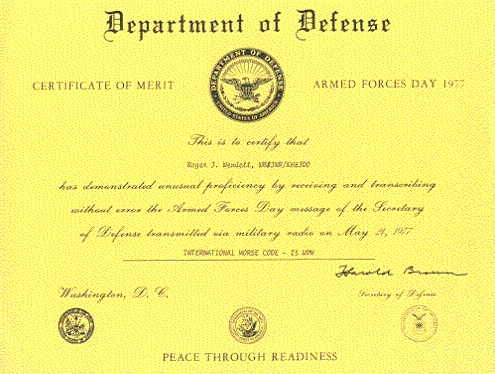
In meeting my requirement to speak to a community group, school, or other organized gathering of citizens – I debuted my presentation tonight to the Wheat State Wireless Association’s April club meeting – located in Paola, KS.
The club had about a dozen members in attendance – seems like a very nice club, a good number hams who were very friendly and welcoming.
Overall, I think the presentation went well. I think I am going to add a slide that shows the specific equipment that I used while in Iraq and maybe another slide showing the WinLink path between Germany, my station in Iraq, and the one in Qatar. I think maybe a handout as well that includes some of the QST articles that talk about amateur operations in Iraq. The presentation time ran about 30 minutes or so. It seemed like the audience was interested and there were a handful of questions afterwards. One young woman approached me afterwards and told me about how her grandfather was a member of Navy MARS during the Vietnam War and operated phone patches. She said she had never really understood what that was about and that my presentation made her realize the great value her grandfather provided the military personnel and their loved ones. She also said she remembered going into his radio room that had racks of old tube radios and the distinct smell that used to produce when they were in operation.
I have my notes mostly finished and will add a link to my presentation slides here soon.
Joseph Sheehan Bicycle Road Race: Today I helped support a 52.9 mile bicycle race between Leavenworth and Atchison, KS. The weather was miserable. A cold morning to begin with. Then rain… and sleet. Even snow. I was positioned at a intersection that crossed the highway which served as about the 10 mile mark and then 40 mile mark on the route back. 52 cyclist made it to the 10 mile point and not more than 20 went on to finish the race. I couldn’t believe that many of the guys hung with it. Those were some dedicated folks.
There were four of us supporting the race, positioned at key spots along the route (inside our nice, warm vehicles). I was able to have several “lessons learned” for this event. I had a distinct lack of planning and preparation.
(1) I didn’t fully check my rig prior to the event. I was at the event site trying to do a radio check with net control with no results.
(2) When it is time to troubleshoot, you have to use logic. When time is short (because of lack of preparation) and problems come up, you have to keep your head. Troubleshooting a radio system is pretty basic. Start from one end and work to the other. Finding that the antenna feedline isn’t properly connected to the rig should be an easy fix.
(3) Having an HT as backup is good. Knowing how to change the settings on it is critical. One of those Nifty manuals or smart cards does the trick.
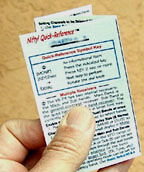
That being said, thanks to the quick thinking of the net control I was able to initially talk to him on my HT using a repeater that didn’t require a tone (I’d forgotten how to change the tone setting on my Kenwood TH-D7A). I eventually figured out how to set the tone and was on the repeater with the other folks. Then with a bit more thought and troubleshooting, I discovered my feedline connection to the rig had come loose and with that fixed I was back in business. Part of the problem is that I have a relatively new rig in the truck, the Kenwood TM-D710A. It is a very complicated rig and I have only scratched the surface on how to operate it. I was able to interface it with the Garmin Nuvi 350 thanks to a cable from Argent Data Systems. The cable allows the D710A to pass APRS data to the Nuvi and the Nuvi plots the data as waypoints. It works pretty well.
I eventually figured out how to set the tone and was on the repeater with the other folks. Then with a bit more thought and troubleshooting, I discovered my feedline connection to the rig had come loose and with that fixed I was back in business. Part of the problem is that I have a relatively new rig in the truck, the Kenwood TM-D710A. It is a very complicated rig and I have only scratched the surface on how to operate it. I was able to interface it with the Garmin Nuvi 350 thanks to a cable from Argent Data Systems. The cable allows the D710A to pass APRS data to the Nuvi and the Nuvi plots the data as waypoints. It works pretty well.

Big week ahead. I mentioned before that I have some specific graduation requirements for the course I am in at Fort Leavenworth. This week I should be able to complete another of the requirements: speak to a community group, school, or other organized gathering of citizens. I have put together a presentation concerning my operations of both amateur radio and MARS station while in Iraq and will be giving the presentation to one of the local amateur radio clubs. The presentation, in addition to my operations, covers the history of the US Army and amateur radio while deployed overseas. It has been fascinating researching the operations of previous Army hams from WWII (Germany and Japan), Korea, Vietnam,

Desert Storm, Afghanistan and Iraq. I also cover the history of amateur radio in Iraq from the early days in the 1920s through the Saddam period and then today. Once I get my slides spiffied up a bit more and add some notes, I will post a link here so those who are interested can take a look. My final requirement is: write professionally by submitting a letter to the editor, Op-Ed piece, or article for publication. My intent is to turn the presentation into an article and then send it to ARRL’s QST. Most of the article is done – I hope to get it completed this week as well.
I am nearing the end of my master’s degree program in international relations. Although the Army’s Command and General Staff College (CGSC) program for us majors is a graduate-level program it does not grant a degree (unlike the Navy, Air Force, and USMC). Apparently this is actually written into the Congressional statue that provides for CGSC – so for whatever the reason, if you want to get a master’s degree while here, you need to do extra work. The program I am in is through Webster University (based out of St. Louis, MO). The military has arrangements with many colleges and universities to run extension programs. Webster’s program here accepts many credits from CGSC. In the end, my requirement has been to take 6 additional classes, two at a time over the course of the last 7 months during the evening. The final requirement is a thesis paper. I am, at long last, done with the six classes and am working on my paper. It has been a tough few last months trying to balance the normal class requirements during the day and meeting the requirements for the classes at night. I will be a happy man when my thesis paper is complete.
As a break from my studies, I went to a National Weather Service (NWS) spotter class sponsored by the Leavenworth County Emergency Services folks. I last attend training back in Virginia. I’d have to say that the people here in Kansas take their weather a bit more serious than the Hampton Roads crowd. The training was conducted at the National Guard Armory in one of the briefing rooms… and the place was packed. It wasn’t just the amateur radio crowd either – there were high school students, CERT members, the elderly Neighborhood Watch types, and the storm chaser fanatics. The class and presentation was excellent, my hat is off to the NWS.
Yesterday we had Gen. Sir Richard Danatt (Chief of the General Staff, the head of the British Army) speak to our CGSC class. It was an excellent talk and he brought up a few key points. As an Army, our focus has been (at least in the last 100 years) on the 3rd phase of operations, the domination phase. The first two phase are deterrent and preparatory and the 4th phase is stability and transition. The domination phase, phase three, can be characterized by major combat operations – and that has always been our focus in training. We close with and destroy the enemy – that is how we have won our wars. Gen. Sir Danatt observed that perhaps the 4th phase is the real decisive operation and I think he makes a good argument for it. I think our Army realizes this is the case, but we don’t have buy in across the board. Gen. Sir Danatt made an observation about the possible French re-entry into NATO. It is a good thing, but he observed that the French Army would be behind the ball when it comes to operating as a team in a NATO operation. They haven’t participated in all the NATO exercises or the associated planning, which will leave them with a steep learning curve to assume a meaningful role in NATO. The last point that Gen. Sir Danatt made that really hit home with me was that if we fail in Afghanistan than it may signal the end of NATO – essentially signifying that NATO is incapable of achieving results. Since the fall of the Soviet empire, the existence and purpose of NATO has always been in question. History tells us that alliances never last forever – it will be interesting to see how long NATO can continue its run.
I am going to see how many little projects I can knock out this weekend – try to take advantage of the good weather…. oh, and also work on my thesis paper.
 The title of this post is a little misleading. As I mentioned before, I am attending the Army’s Command & General Staff College (CGSC) here at Fort Leavenworth, Kansas (… I bet you thought I was out here in Kansas just for the nice weather). One of the new requirements we have as students at is to egage in “Strategic Communication”. Wikipedia defines strategic communications as: communicating a concept, a process, or data that satisfies a long term strategic goal of an organization by allowing facilitation of advanced planning. Our requirements as students to engage in strategic communication does not exactly line up with that definition, but I think it gives you an idea of where the Army is headed. The bottom line is the Army wants to develop officers who are familiar and comfortable in dealing with the media in order to get the Army’s “message” out. In the past the military has been traditionally media shy (understatement), either making heavy use of the “no comment” or deferring to our public relations officers. No more. The Army recognizes this is the new media age and those that get their story out first, in a clear and understandable fashion are likely to better garner public support… both domestic and international. Okay… so back to school. My requirements, as related to strategic communications, are to: (1) participate in an actual media interview (television, print, or radio), (2) speak to a community group, school, or other organized gathering of citizens, (3) write professionally by submitting a letter to the editor, Op-Ed piece, or article for publication, and (4) participate in a reputable blog about their military service.
The title of this post is a little misleading. As I mentioned before, I am attending the Army’s Command & General Staff College (CGSC) here at Fort Leavenworth, Kansas (… I bet you thought I was out here in Kansas just for the nice weather). One of the new requirements we have as students at is to egage in “Strategic Communication”. Wikipedia defines strategic communications as: communicating a concept, a process, or data that satisfies a long term strategic goal of an organization by allowing facilitation of advanced planning. Our requirements as students to engage in strategic communication does not exactly line up with that definition, but I think it gives you an idea of where the Army is headed. The bottom line is the Army wants to develop officers who are familiar and comfortable in dealing with the media in order to get the Army’s “message” out. In the past the military has been traditionally media shy (understatement), either making heavy use of the “no comment” or deferring to our public relations officers. No more. The Army recognizes this is the new media age and those that get their story out first, in a clear and understandable fashion are likely to better garner public support… both domestic and international. Okay… so back to school. My requirements, as related to strategic communications, are to: (1) participate in an actual media interview (television, print, or radio), (2) speak to a community group, school, or other organized gathering of citizens, (3) write professionally by submitting a letter to the editor, Op-Ed piece, or article for publication, and (4) participate in a reputable blog about their military service.
#4 is pretty easy. I think I can figure out how to blog.
#3 not too hard. I can either repurpose one of my existing papers and send in to a newspaper or I can try to be original and maybe send something in to ARRL.
#2 is a bit harder. What I have decided to do for that is put together a presentation of amateur radio operations by military members who are deployed… kind of a DXpedition in a Combat Zone. I have a lot of information on amateur radio operations by folks in both Afghanistan and Iraq and I can use my own experience as well. Then I have to find an amateur radio club to give the talk to. Ideally I need to have all of this complete by the end of March.
…and #1. That is the hardest, in my opinion. Knowing the challenge of this particular requirement, our instructors are allowing us to get credit if we are able to call and get on a radio talk show. This interpretation makes the requirement a little less severe. Now I have to find a radio talk show to call. There are several here in the Kansas City area that I am scoping out:
KCUR: Up To Date
KMBZ: Shanin & Parks
I also found some great advise on how to be prepared before I call at both NPR and KCUR.
Wish me luck.